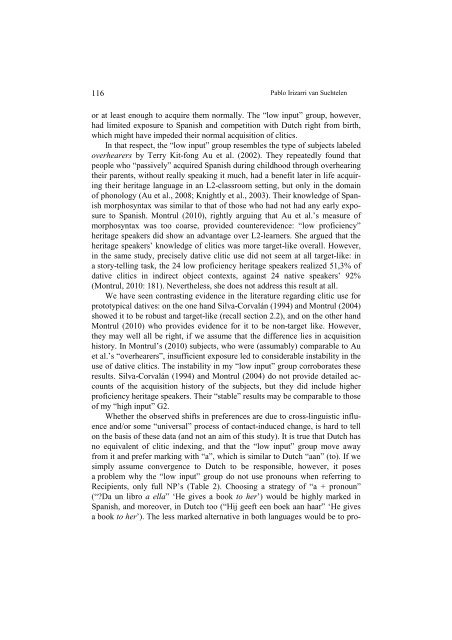s - Wyższa SzkoÅa Filologiczna we WrocÅawiu
s - Wyższa SzkoÅa Filologiczna we WrocÅawiu
s - Wyższa SzkoÅa Filologiczna we WrocÅawiu
You also want an ePaper? Increase the reach of your titles
YUMPU automatically turns print PDFs into web optimized ePapers that Google loves.
116<br />
Pablo Irizarri van Suchtelen<br />
or at least enough to acquire them normally. The “low input” group, ho<strong>we</strong>ver,<br />
had limited exposure to Spanish and competition with Dutch right from birth,<br />
which might have impeded their normal acquisition of clitics.<br />
In that respect, the “low input” group resembles the type of subjects labeled<br />
overhearers by Terry Kit-fong Au et al. (2002). They repeatedly found that<br />
people who “passively” acquired Spanish during childhood through overhearing<br />
their parents, without really speaking it much, had a benefit later in life acquiring<br />
their heritage language in an L2-classroom setting, but only in the domain<br />
of phonology (Au et al., 2008; Knightly et al., 2003). Their knowledge of Spanish<br />
morphosyntax was similar to that of those who had not had any early exposure<br />
to Spanish. Montrul (2010), rightly arguing that Au et al.’s measure of<br />
morphosyntax was too coarse, provided counterevidence: “low proficiency”<br />
heritage speakers did show an advantage over L2-learners. She argued that the<br />
heritage speakers’ knowledge of clitics was more target-like overall. Ho<strong>we</strong>ver,<br />
in the same study, precisely dative clitic use did not seem at all target-like: in<br />
a story-telling task, the 24 low proficiency heritage speakers realized 51,3% of<br />
dative clitics in indirect object contexts, against 24 native speakers’ 92%<br />
(Montrul, 2010: 181). Nevertheless, she does not address this result at all.<br />
We have seen contrasting evidence in the literature regarding clitic use for<br />
prototypical datives: on the one hand Silva-Corvalán (1994) and Montrul (2004)<br />
sho<strong>we</strong>d it to be robust and target-like (recall section 2.2), and on the other hand<br />
Montrul (2010) who provides evidence for it to be non-target like. Ho<strong>we</strong>ver,<br />
they may <strong>we</strong>ll all be right, if <strong>we</strong> assume that the difference lies in acquisition<br />
history. In Montrul’s (2010) subjects, who <strong>we</strong>re (assumably) comparable to Au<br />
et al.’s “overhearers”, insufficient exposure led to considerable instability in the<br />
use of dative clitics. The instability in my “low input” group corroborates these<br />
results. Silva-Corvalán (1994) and Montrul (2004) do not provide detailed accounts<br />
of the acquisition history of the subjects, but they did include higher<br />
proficiency heritage speakers. Their “stable” results may be comparable to those<br />
of my “high input” G2.<br />
Whether the observed shifts in preferences are due to cross-linguistic influence<br />
and/or some “universal” process of contact-induced change, is hard to tell<br />
on the basis of these data (and not an aim of this study). It is true that Dutch has<br />
no equivalent of clitic indexing, and that the “low input” group move away<br />
from it and prefer marking with “a”, which is similar to Dutch “aan” (to). If <strong>we</strong><br />
simply assume convergence to Dutch to be responsible, ho<strong>we</strong>ver, it poses<br />
a problem why the “low input” group do not use pronouns when referring to<br />
Recipients, only full NP’s (Table 2). Choosing a strategy of “a + pronoun”<br />
(“?Da un libro a ella” ‘He gives a book to her’) would be highly marked in<br />
Spanish, and moreover, in Dutch too (“Hij geeft een boek aan haar” ‘He gives<br />
a book to her’). The less marked alternative in both languages would be to pro-
















